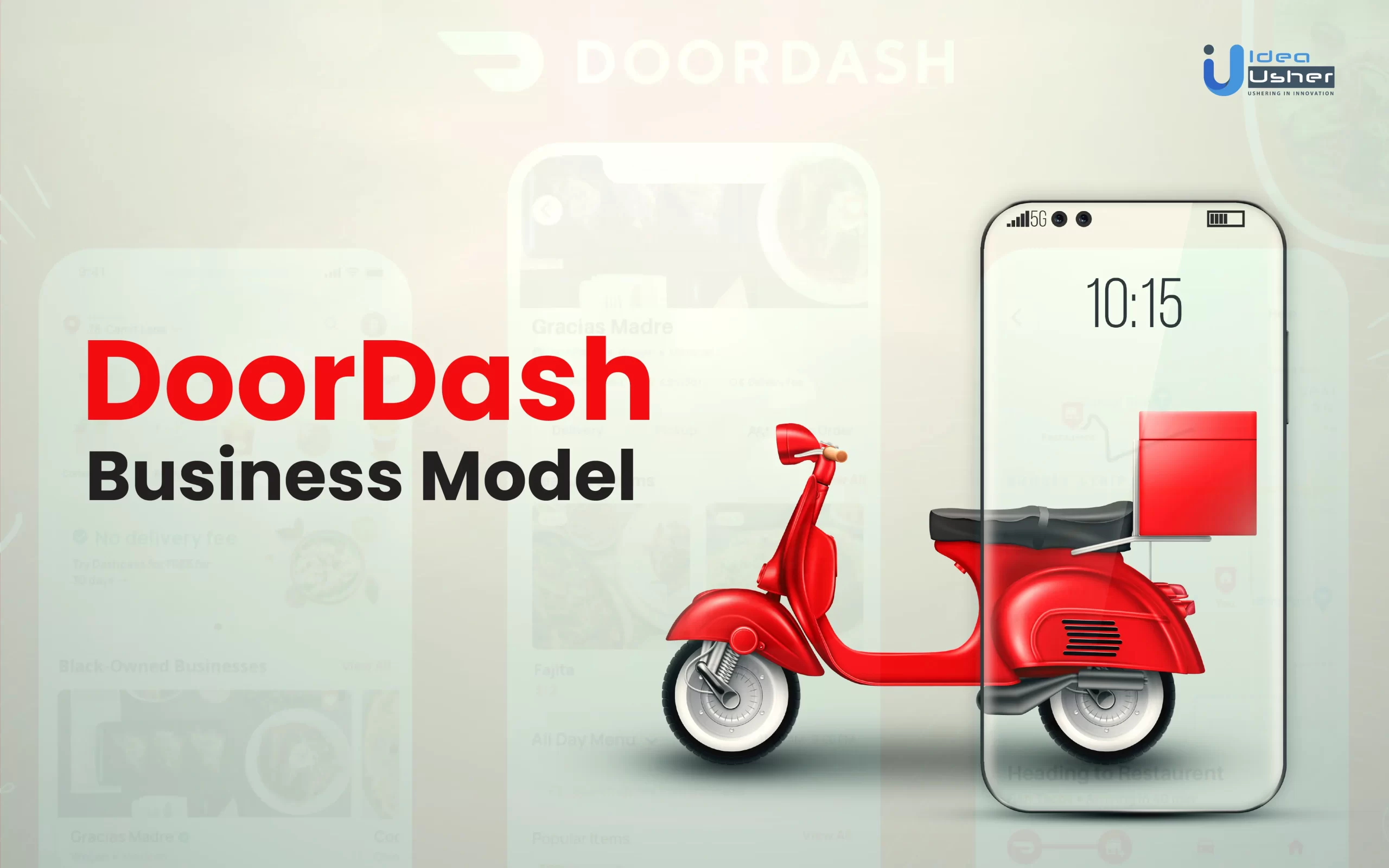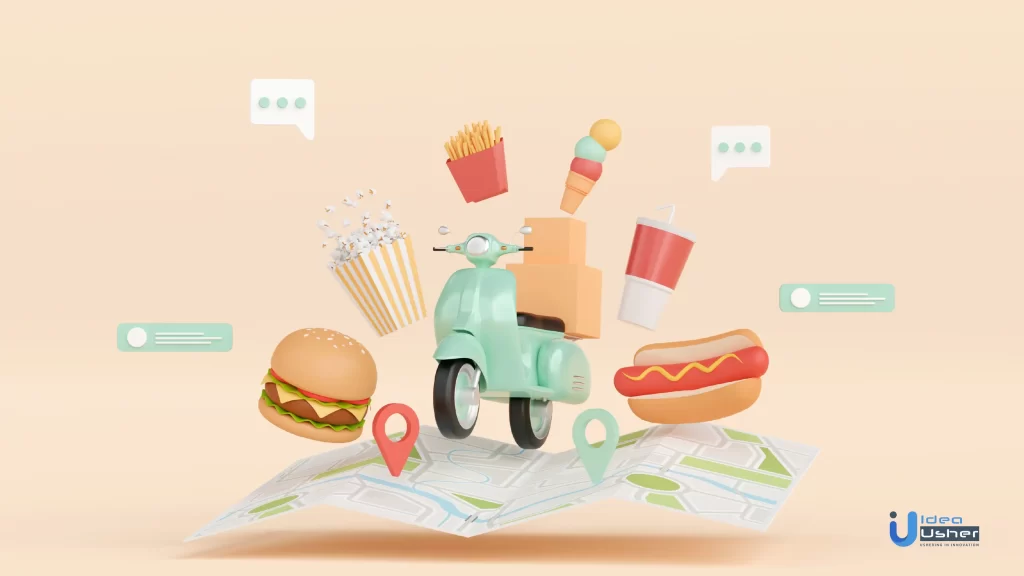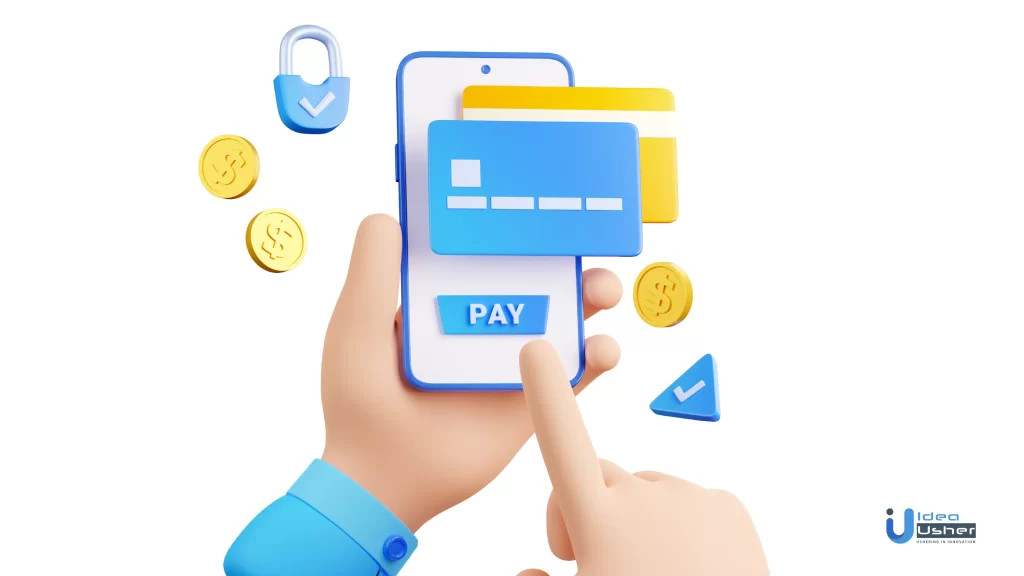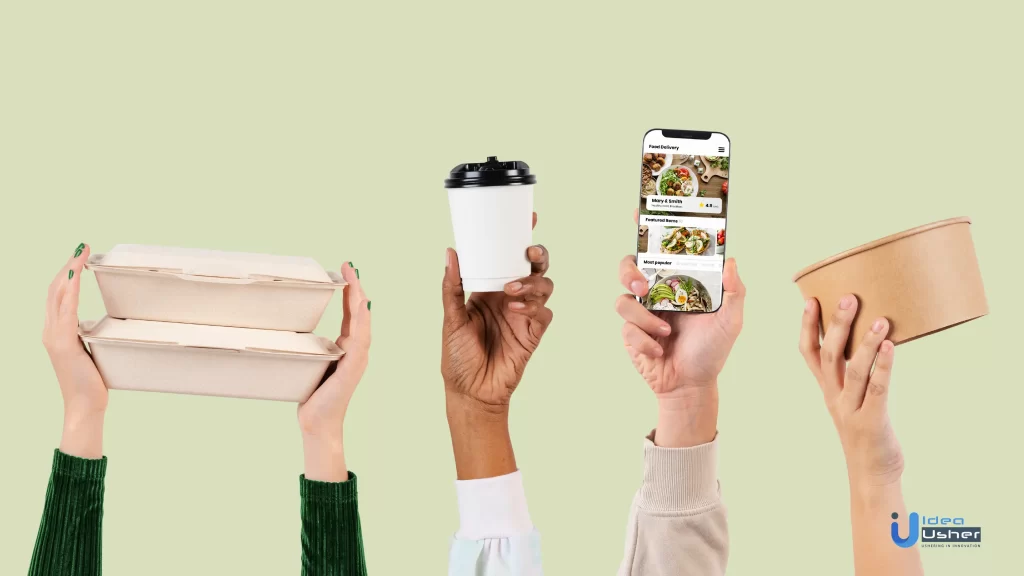- What is DoorDash?
- Here are some amazing facts about the DoorDash
- How Does DoorDash Works?
- User Base of DoorDash
- What is the Revenue Model of DoorDash?
- What is the Primary Revenue Model of DoorDash?
- Future Analysis of Food delivery Business in the dynamic world.
- Future Analysis of DoorDash.
- DoorDash Analysis with its competitors
- What Challenges that Food Delivery Apps Face?
- Future of Food Delivery Apps
- Wrapping Up
- FAQ’s

Food delivery apps have grown exponentially in popularity and usage in recent years. The convenience of ordering food from the comfort of one’s home has made these apps a staple in the modern era of technology. With the integration of GPS tracking and real-time order updates, customers can track their food and delivery status. Artificial intelligence and machine learning algorithms have allowed personalized recommendations and streamlined order processes, resulting in a more efficient and enjoyable experience for customers and restaurant owners.
The growth of food delivery apps has also led to an increase in online ordering and a decrease in the need for physical menus and phone orders. As technology advances, food delivery apps are likely to further integrate with other platforms and services, such as social media and smart home devices. Overall, food delivery apps have significantly impacted the food industry and will continue to do so in the foreseeable future. in this article, we will discuss doordash and its business model.
- What is DoorDash?
- Here are some amazing facts about the DoorDash
- How Does DoorDash Works?
- User Base of DoorDash
- What is the Revenue Model of DoorDash?
- What is the Primary Revenue Model of DoorDash?
- Future Analysis of Food delivery Business in the dynamic world.
- Future Analysis of DoorDash.
- DoorDash Analysis with its competitors
- What Challenges that Food Delivery Apps Face?
- Future of Food Delivery Apps
- Wrapping Up
- FAQ’s
What is DoorDash?
DoorDash is an online food delivery app started by the four greatest minds from Stanford University, Tony Xu, Stanley Tang, Andy Fang, and Evan Moore, in 2013.
Y-combinator has invested in the startup. As a technology firm, it employs user logistics to supply users with restaurant meal delivery services.
The firm originated in Sao Alto and has since spread to over 4000 cities and over 340 000 locations throughout America and Canada.
Here are some amazing facts about the DoorDash
- In the year 2013, the firm was founded in Palo Alto.
- Tony Xu, Stanley Tang, Andy Fang, and Evan Moore, four Stanford students, founded the firm.
- Their conversations inspired the service with Chloe, the owner of Chantal Guillon, a macaroon shop in Palo Alto.
- The headquarters of the corporation are in San Francisco, California.
- Y-Combinator has invested in the startup.
- In 2019, DoorDash overtook GrubHub, the largest third-party delivery service.
- DoorDash is the largest third-party delivery service in the United States as of 2019.
- DoorDash was named the employer of the year in 2019.
- The company’s total sales were $900 million as of December 2019.
How Does DoorDash Works?
Here is the basic functioning of how DoorDash works and runs its operations. Here is no rocket science in its working. The app works just like every food delivery app and follows the primary golden rules of food delivery apps that are discussed below.
Placing The Order

Users have a lot of alternatives when it comes to dining because there are so many eateries to pick from. Users may view the most popular orders from consumers in any restaurant and choose their favorites. Users receive recommendations for new options based on prior orders. Users may place orders by selecting from all available choices.
Paying the Bill

When users have placed their purchase, the following step is to pay for it. The total amount is computed based on the Restaurant and the delivery location. Users can make payments using the app using different payment methods, and the order is sent to the appropriate restaurant for preparation and shipment when the users have paid.
Dispatch

When an order is ready from the restaurant, delivery staff (Dashers), pick it up and proceed to the delivery site. Dashers may use the app to pick up orders anytime they have free time.
The tracking tool accessible in the app allows customers to follow the status of their orders.
Delivery

Dasher’s objective is to complete the order as quickly as possible. The delivery charge is paid to the firm, and the company compensates dashers for their services.
On the other hand, Dashers frequently earn gratuities from customers based on how the client perceives the dasher’s work. The app lets users rate their dasher, delivery, and order experiences.
User Base of DoorDash
Here is what comprises the significant stakeholders of the doordash
Eateries
The Eateries are a critical component of the DoorDash operation. These restaurants are in the app for a variety of reasons. Let’s see what happens.
DoorDash is popular among restaurants that do not offer home delivery services. DoorDash is advantageous to any food business because of its efficient transportation network.
Companies seeking new methods to reach customers may also find it handy. Given DoorDash’s popularity and breadth of offerings, these eateries may profit and get a new audience while still delivering to existing customers.
Companies that need a better seating plan might profit from Doordash’s home delivery service.
Users
Individuals who adore cuisine but lack the time or energy to dress up and go out to eat appreciate DoorDash.
A business environment with little time to squander may use DoorDash to arrange small or large orders (Group orders) without violating their work schedules.
Individuals who do not have kitchens in their flats or cannot use them for various reasons.
Individuals who dislike cooking and prefer to dine out like the DoorDash service.
From small to big, every eatery can benefit in one way or another from DoorDash, and this has been the secret behind the service’s popularity.
What are the services that doordash offers to its customers?
Here are some of the top 5 services DoorDash offers –
1. Top Menu
Customers may check the most popular restaurant dishes and decide what to eat.
2. Recommended List
Based on user preferences, the app leverages AI to provide users with a suggested list of items to try.
3. Schedule Delivery
Given people’s hectic schedules, arranging orders ahead of time is more accessible. Users may pre-arrange delivery dates with DoorDash to minimize last-minute confusion or other inconveniences.
4. Live Tracking
Users may monitor the order’s path through the app in real time from when it leaves the restaurant.
5. Dual Rating
A dual rating system, which includes separate ratings for food and delivery, allows users to describe their experience better.
The primary stakeholder in the whole business model is the users since they place the orders, pay the delivery charges, and order from the eateries. Thus the company offers many benefits to the users, like coupons, offers, and bonuses.
Customers also receive personal customer care 24 hours a day, seven days a week, which is a huge convenience. DoorDash’s efficient customer assistance has aided consumers and DoorDash in understanding users.
Dashers
Dashers are the delivery personnel of the doordash business model.
Dashing is a good option for anyone searching for flexible work with flexible schedules. These applicants must have transportation for delivery.
Individuals seeking an excellent job with good tips are also dasher material.
Dashers are paid a weekly fixed rate for their deliveries and typically make more than $600. (US). Customer tips are essential to Dasher’s incentive for working at DoorDash. Dashers may determine their working hours; they are more likely to receive generous tips if they are efficient. It is simple to be a dasher, and the rewards are well worth the effort.
Dashers are an integral part of the business model since they are the ones who are physically connected to the eateries, and the user company must offer the dashers significant incentives to keep them motivated.
What is the Revenue Model of DoorDash?
Here is the primary revenue model for all the food delivery companies.
1. Subscription-based revenue model
Some food delivery apps offer subscription-based services that provide users with exclusive discounts, free delivery, and other perks. Users pay a monthly or yearly fee to access these services, which can generate a recurring revenue stream for the app.
2. Dynamic pricing
Food delivery apps may also use dynamic pricing to generate revenue. This involves adjusting the prices of menu items based on factors such as demand, time of day, and weather conditions. The app can generate more revenue from each order by increasing costs during peak demand times.
3. In-app purchases
Some food delivery apps offer in-app purchases such as meal upgrades, extra toppings, or faster delivery times. The app earns money each time a user makes an in-app purchase.
4. Partnerships
Food delivery apps may partner with other businesses to generate revenue. For example, a food delivery app could partner with a grocery store to offer delivery services for groceries, earning a commission on each order.
Overall, the revenue model of food delivery apps is primarily based on commission fees charged to restaurants and delivery fees set to customers. However, these apps also explore other revenue streams to increase profitability, such as advertising, subscriptions, dynamic pricing, in-app purchases, and partnerships.
What is the Primary Revenue Model of DoorDash?
DoorDash has been able to pique the interest of investors and to do so, an effective revenue model is required. For a business like DoorDash to succeed in the market, it must provide strong returns. Only then will investors be interested in supporting such ventures. With its rapid ascent in the industry, DoorDash has consistently gained investors’ trust.
DoorDash generates income in a variety of ways. Let me now discuss these various revenue creation approaches.
1. Commercial Commissions
DoorDash enables businesses to reach their target audience with minimal effort. It allows any user to order from their favorite restaurants, even if such restaurants do not have delivery services. It is a fantastic service for restaurants needing help to afford their transportation system or prefer to focus on their products rather than transportation.
DoorDash receives a commission from the company for offering this service, typically approximately 20%. Restaurants are okay with paying the fee because it saves them much time.
2. Delivery Charge
DoorDash has a vast transportation network and utilizes delivery employees known as dashers to deliver various orders placed by clients. The corporation compensates these consumers, and customers also give them suggestions based on their performance.
DoorDash charges companies a fee to deliver orders to their clients. In addition, DoorDash charges consumers a delivery fee between $5 and $8. Customers may use DoorDash to order meals from restaurants that do not deliver. Customers find it quicker to use the app than to go through a lot of work because there are so many restaurants and foods to choose from and simple and unique features.
3. Promotion
In addition to the preceding two services, DoorDash offers advertising services to restaurants. Although companies are displayed on the website and app for customers to see, they receive no priority and rely on user evaluations.
Businesses can go to the forefront of the process and reach more consumers than ever before with DoorDash Advertising. It is also an essential source of revenue for DoorDash, allowing businesses to take advantage of DoorDash’s broad reach.
This is how DoorDash gets income and has become the largest third-party delivery service in the United States. The company’s growth graph has been outstanding and shows no signs of slowing down.
Above are the techniques used for doordash to generate revenue. Thus as of March 2023, DoorDash is worth more than 20.7 Billion Dollars.
Future Analysis of Food delivery Business in the dynamic world.
According to a report by Zion Market Research, the food delivery industry has seen rapid growth in recent years, with the global food delivery market expected to reach $154 billion by 2023. Here are some possible future trends and analyses for food delivery businesses:
1. Continued Growth
With the COVID-19 pandemic increasing the demand for food delivery services, the industry is expected to grow in the coming years. More people are ordering food online and using delivery apps to get meals from their favorite restaurants, even as restrictions ease.
2. Greater Emphasis on Health and Sustainability
As people become more health conscious and environmentally aware, food delivery businesses will likely offer healthier and more sustainable options. This could include partnerships with local farmers, offering more plant-based options, and using eco-friendly packaging.
3. Expansion of Ghost Kitchens
Ghost kitchens are commercial kitchens that cater exclusively to food delivery orders and have become increasingly popular in recent years. With the rise of virtual restaurants and delivery-only concepts, ghost kitchens will likely become more widespread, allowing food delivery businesses to offer a wider variety of cuisines.
4. Technology Innovations
Technology will continue to play a significant role in the food delivery industry, with businesses investing in AI-powered chatbots, drones, and other delivery methods to improve efficiency and customer experience. Additionally, blockchain technology could increase transparency in the food supply chain, from sourcing to delivery.
5. Increased Competition and Consolidation
With the industry overgrowing, competition will intensify, and smaller food delivery businesses may need help to keep up. This could lead to consolidation in the industry, with larger companies acquiring smaller ones to expand their reach and market share.
Overall, the future of food delivery businesses looks bright, with continued growth, innovation, and emphasis on health, sustainability, and technology. However, the industry will also face challenges, such as increasing competition and the need to adapt to changing consumer preferences and behaviors.
Future Analysis of DoorDash.
DoorDash surpassed GrubHub to become the most widespread third-party delivery service in the United States in 2019. It was able to do this via ongoing innovation and astute commercial methods. Doordash, as a technology firm, strives to make the service as accessible to companies as it is to individuals. Its focused customer assistance is another factor contributing to its rising popularity. DoorDash showed no indications of slowing down towards the end of 2019 and the start of 2020.
In an era where companies are finding it difficult to navigate and have few options for working, DoorDash has made specific efforts to guarantee that it can help as many businesses and individuals as possible.
In February, the business filed for an IPO on a secret basis. Throughout the outbreak, the organization has attempted to assist companies in remaining in the workplace and guaranteeing a safe workflow.
DoorDash Analysis with its competitors
DoorDash is one of the leading food delivery companies in the United States, along with competitors such as Uber Eats, Grubhub, and Postmates. Here is a comparative analysis of DoorDash with its competitors:
1. Market Share
DoorDash has the largest market share in the United States, with 56% of the food delivery market as of September 2021. Uber Eats follows closely behind with 28%, while Grubhub and Postmates have smaller market shares.
2. Geographic Reach
DoorDash operates in over 4,000 cities in the United States, Canada, and Australia, giving it a wider geographic reach than its competitors. Uber Eats operates in over 6,000 cities in over 45 countries, while Grubhub primarily operates in the United States.
3. User Experience
DoorDash offers a user-friendly app and website with features like group orders, scheduled delivery, and contactless delivery options. Uber Eats, and Grubhub provides similar features, while Postmates has a more minimalist app design.
4. Restaurant Partnerships
DoorDash partners with over 450,000 restaurants, offering users various cuisine options. Uber Eats partners with over 600,000 restaurants globally, while Grubhub partners with over 300,000, primarily in the United States.
5. Revenue and Growth
DoorDash has seen significant revenue growth in recent years, with $2.9 billion in 2020. Uber Eats, Grubhub, and Postmates also saw revenue growth, with Uber Eats generating $4.7 billion in revenue in 2020, Grubhub generating $2.4 billion, and Postmates generating $950 million before its acquisition by Uber.
6. Delivery Fees and Commission Rates
DoorDash charges a delivery fee to users and a commission fee to restaurants, which varies based on factors such as order value and location. Uber Eats, Grubhub, and Postmates also have similar fee structures, going by market and restaurant.
Overall, DoorDash has the largest market share and most expansive geographic reach among food delivery competitors in the United States. Its user-friendly app and website, a wide range of restaurant partnerships, and revenue growth are also strengths. However, competition in the industry is intense, with Uber Eats, Grubhub, and Postmates offering similar features and services.
What Challenges that Food Delivery Apps Face?
As the food delivery industry continues to grow, food delivery apps will face several challenges in the future, including:
1. Intense Competition
The food delivery market is highly competitive, with several significant players vying for market share. As new players enter the market and existing players expand their services, food delivery apps must differentiate and offer unique features and benefits to attract and retain customers.
2. Rising Costs
The cost of doing business in the food delivery industry is high, with expenses related to driver wages, marketing, and technology. As competition heats up and customers become more price-sensitive, food delivery apps may need help maintaining profitability while keeping prices competitive.
3. Labor Issues
Food delivery apps rely heavily on gig workers, who are not considered employees and do not receive benefits such as healthcare or paid time off. As labor laws evolve and more scrutiny is placed on gig work, food delivery apps may face increased pressure to offer more benefits and protections for their workers.
4. Regulatory Challenges
Food delivery apps may face regulatory challenges as local and national governments seek to regulate the industry. This could include requirements around minimum wages for drivers, food safety standards, or restrictions on using specific delivery methods, such as drones or autonomous vehicles.
5. Changing Consumer Preferences
As consumer preferences evolve, food delivery apps must adapt their services and offerings to keep pace. This could include offering more sustainable packaging options, catering to specific dietary needs, or partnering with local farmers and food producers to provide locally sourced ingredients.
6. Technology Advances
As technology advances, food delivery apps must stay ahead of the curve to offer the most efficient and user-friendly service possible. This could include using artificial intelligence, chatbots, and other technologies to improve the delivery experience and reduce costs.
The food delivery industry is poised for continued growth, but food delivery apps must navigate these challenges to succeed in the long term.
Future of Food Delivery Apps
Food delivery apps have grown in popularity in recent years, driven by consumer demand for convenience and speed. The future of food delivery apps looks promising as the market is expected to continue to grow at a rapid pace. Here are some of the trends and factors that are likely to shape the future of food delivery apps:
1. Increased Technology Adoption
Technology use in the food delivery industry will become more sophisticated and efficient. This includes using machine learning, artificial intelligence, and big data analytics to understand customer preferences better and optimize delivery routes.
2. Expansion of Service Offerings
Besides delivering food from restaurants, food delivery apps will likely expand their service offerings to include grocery delivery, alcohol delivery, and prescription medicine.
3. Growing Popularity of Ghost Kitchens
Ghost kitchens, commercial kitchens catering to delivery-only restaurants, are becoming more popular. As more restaurants adopt this model, food delivery apps will offer their customers a more comprehensive selection of food options.
4. Integration with Smart Devices
Food delivery apps are expected to integrate with smart home devices such as Amazon Echo and Google Home to allow customers to order food through voice commands.
5. Increased Focus on Sustainability
Food delivery apps must focus on sustainability as consumers become more environmentally conscious. This includes reducing single-use plastics and implementing more eco-friendly delivery options.
Overall, the future of food delivery apps looks promising as they continue to meet the evolving needs of consumers. However, the industry must address challenges such as food safety, delivery times, and the high commission fees charged to restaurants to maintain their success.
Wrapping Up
The business model of food delivery apps such as DoorDash is built around connecting customers with local restaurants, allowing them to order food for delivery or pickup. The app charges a commission fee to restaurants for each order, typically ranging from 15-30% of the order value. In addition, DoorDash also charges customers a delivery fee for each order, which can vary based on the distance and demand for delivery services in the area.
Food delivery apps like DoorDash rely on a large, loyal customer base to ensure profitability. They use various marketing strategies, such as referral programs and discounts, to attract and retain customers.
If you are interested in building a food delivery app like DoorDash and generating a revenue stream, there are several key considerations to remember. First, it is essential to identify your target market and understand their needs and preferences.
You must also develop a user-friendly app with cutting-edge technology to provide a seamless and efficient user experience. Additionally, you must establish partnerships with local restaurants and build a robust delivery network to ensure timely and reliable service.
At Idea Usher, we specialize in developing custom food delivery apps that are tailored to your specific business needs. Our team of experienced developers and designers can help you create a high-quality, user-friendly app that meets the demands of today’s competitive market. Contact us today to learn how we can help you build a successful food delivery app.
FAQ’s
Q. How Long Does it take to build an app like DoorDash?
A. Although the time required varies based on the features and complexity of an app, a doordash app may be produced in 7-15 days.
Q. What are the essential features to include in a food delivery app?
A. Essential features to include in a food delivery app are user registration, restaurant listing, menu listing, payment integration, order tracking, customer support, reviews and ratings, push notifications, and loyalty programs.
Q. How to ensure the security of transactions made on a food delivery app?
A. To ensure the security of transactions made on a food delivery app, it is crucial to integrate secure payment gateways such as PayPal or Stripe. Additionally, SSL encryption should be implemented to secure user data, and two-factor authentication should be implemented to prevent fraudulent activities. Regular security audits should be conducted to identify and fix any vulnerabilities.
Q. How much does it cost to develop a food delivery app?
A. The cost of developing a food delivery app depends on various factors, such as the complexity of the app, features included, design, development platform, and location of the development team. It can cost between $25,000 to $100,000 or more.









Rachit Gilhotra